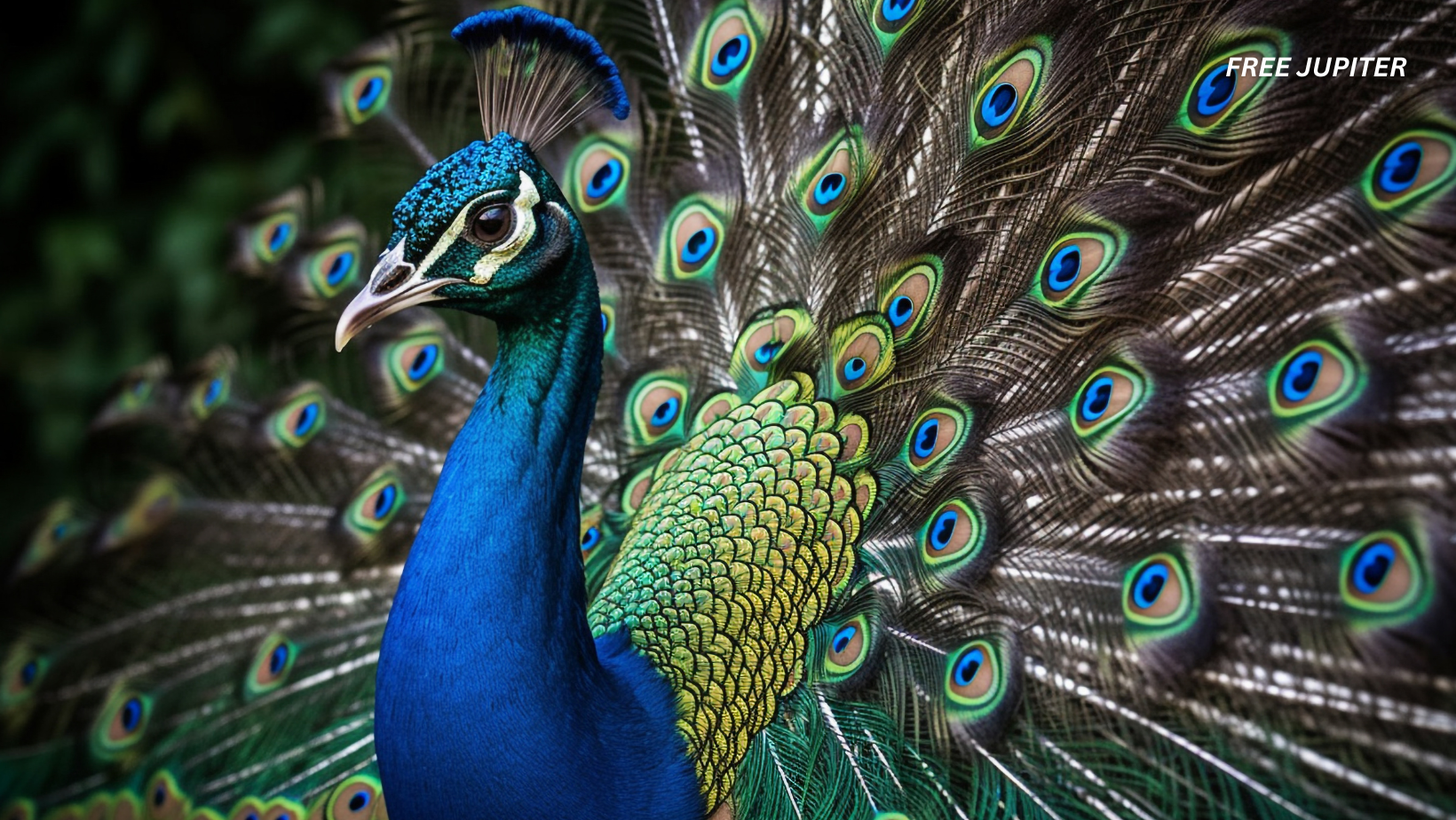Friendly Note: FreeJupiter.com shares general info for curious minds 🌟 Please fact-check all claims—and always check health matters with a professional 💙
When people think of a peacock, they usually picture its radiant tail fanned out like a living rainbow. These shimmering feathers have inspired poets, artists, and even fashion designers for centuries. But now, scientists are looking at them with a whole new sense of awe—because they may have discovered that peacock feathers can do something that sounds straight out of a science fiction novel: produce real laser-like beams of light.
Yes, the bird that struts in gardens, temples, and palaces may secretly be hosting the world’s first biological laser show.
What Scientists Actually Found
The discovery came about when researchers decided to test the optical properties of the peacock’s most iconic feature—its vibrant eyespots. These colorful “eyes” are not painted by pigments but created by the feather’s microscopic architecture, which bends, scatters, and reflects light in precise ways.
When scientists shone pulses of light at these feathers, after coating them with a fluorescent dye, they noticed something astonishing. Instead of scattering light in all directions, the feathers managed to focus and amplify it into a sharp, yellow-green beam of laser-like light.
This means the peacock’s feathers behaved much like a laser cavity, which is essentially the heart of any man-made laser device.
A Quick Detour: How a Laser Works
For those not steeped in physics, here’s the simplest way to picture it. A laser (short for Light Amplification by Stimulated Emission of Radiation) works by forcing light waves to line up and move in unison. Normally, light scatters chaotically—imagine the glow of a candle or a flashlight. But in a laser, the light is “trained,” creating an intense, focused beam.
The key to making this happen is a laser cavity, which traps light between reflective surfaces until it becomes amplified and emerges as a concentrated ray.
Now here’s the quirky twist: the peacock’s feather seems to have naturally evolved something that mimics this process—without engineers, glass lenses, or high-tech mirrors.
Read more: A Brain Chip Can Now Read Human Thoughts With 74% Accuracy
The Peacock Feather as a Natural Laser
The eyespots of a peacock feather are made up of nanostructures—tiny arrangements on the scale of billionths of a meter—that create its shimmering iridescence. These nanostructures don’t just make the feather beautiful; they also interact with light in unusual ways.
When the fluorescent dye was added, these structures essentially acted like built-in optical traps. Instead of light bouncing randomly, it got caught, reinforced, and pushed out in a precise direction—just like in a human-made laser.
This marks the first documented case of a “biolaser” in the animal kingdom.
Why This Discovery Is Such a Big Deal
At first glance, you might shrug and think, “That’s neat, but so what?” But the implications reach far beyond bird feathers.
- New Medical Tools:
Lasers are already used in eye surgery, cancer detection, and dental work. If scientists can understand and copy the natural structures in peacock feathers, they may design new bio-inspired lasers that are safer, cheaper, and even more precise. - Virus and Disease Detection:
The study suggests that such natural laser effects could one day help identify viruses or other microscopic threats. Imagine a handheld scanner that uses a feather-like structure to detect illnesses instantly. - Environmental Applications:
Just as lasers can measure pollutants in the air or water, bio-inspired designs could provide more sensitive and eco-friendly monitoring systems. - Optical Devices of the Future:
From sharper microscopes to futuristic communication systems, the possibilities of integrating “feather technology” into everyday tools are vast.
The Beauty of Structural Color
To truly appreciate this discovery, it helps to understand what makes peacock feathers look so dazzling in the first place.
Unlike pigments (like paint), which absorb and reflect certain wavelengths of light, peacock feathers rely on structural coloration. This means that the colors are created by the way light interacts with the feather’s tiny internal structures.
It’s similar to how a soap bubble or an oil slick shimmers with rainbow-like colors. The patterns aren’t painted on—they’re created by interference between light waves.
This kind of structural brilliance is not unique to peacocks. Butterflies, beetles, hummingbirds, and even some fish use it too. But in the peacock’s case, the arrangement is so precise that it may actually cross the line from “pretty colors” into functional laser optics.
Are Peacocks Shooting Lasers at Each Other?
Before you start imagining dueling birds blasting laser beams across a garden, let’s clarify: peacocks in the wild are not running around with built-in weapons. The laser effect only happens under controlled lab conditions, with a fluorescent dye and external light pulses added.
So, the feathers don’t naturally emit laser beams during courtship displays. Instead, they remain the dazzling, iridescent fans we already know. Still, the fact that the potential exists shows just how incredible nature’s designs can be.
Biolasers Beyond the Peacock
Interestingly, the idea of a “biolaser” isn’t brand new. In previous research, scientists managed to make laser-like emissions from human cells when placed between mirrors and infused with dye. Jellyfish proteins have also been tested in similar ways.
But what sets the peacock apart is that it didn’t need extra mirrors or artificial chambers. Its feathers themselves acted as the laser cavity. In other words, evolution seems to have unknowingly engineered a natural optical device millions of years before humans did.
Read more: What People Say They Saw “On the Other Side” After Dying And Coming Back To Life
The Cultural Side of the Peacock
Beyond science, the peacock has held symbolic power for centuries. In India, it’s the national bird and a sacred creature tied to deities. In Greek mythology, the peacock’s tail was said to represent the hundred eyes of Argus. In Chinese tradition, it symbolizes dignity and beauty.
Now, with this laser-like twist, the bird may gain a new symbolic layer: a bridge between nature’s elegance and technological innovation.
What Scientists Still Don’t Know
Despite the excitement, many questions remain unanswered:
- Why does the structure amplify light so effectively?
- Could other animals have similar hidden laser-like properties?
- Can this effect be recreated outside of a lab without dyes?
- Did evolution shape the feather structures purely for beauty, or might there be a hidden functional reason?
The answers to these questions could open entirely new fields of study at the intersection of biology and physics.
Nature as a Silent Engineer
The peacock’s accidental laser show highlights a larger truth: nature often designs things far more sophisticated than human engineers. From spider silk that’s stronger than steel to gecko feet that cling better than glue, the natural world is filled with technologies waiting to be discovered.
The peacock feather now joins this list—a reminder that beauty in nature often hides unexpected secrets.
The Future of Feather-Inspired Technology
Looking ahead, researchers believe that understanding natural laser systems could lead to:
- Non-invasive medical scans using biolaser technology.
- Light-powered sensors small enough to fit into wearable devices.
- Energy-efficient optics inspired by the feather’s structure.
- Eco-friendly materials that mimic structural coloration without harmful dyes or plastics.
Who knew that a stroll past a peacock in a park might one day inspire the next leap in medical imaging or environmental science?
Read more: Synthetic Dyes Are Out: Skittles, M&M’s, and More Go Natural by 2026
A Final Thought: Beauty With Hidden Depth
At first glance, a peacock’s feather is simply one of nature’s most beautiful displays—brilliant, colorful, and full of life. But as this discovery shows, hidden within its delicate structure is a potential technology that could transform science, medicine, and engineering.
It’s a humbling reminder that the natural world is not just decorative—it is deeply functional. And sometimes, what looks like a shimmering fan of beauty may also be a whisper of tomorrow’s innovations.
So, the next time you see a peacock proudly showing off its feathers, don’t just admire the surface. Somewhere within those eyespots might be the flicker of the world’s first natural laser light show.










